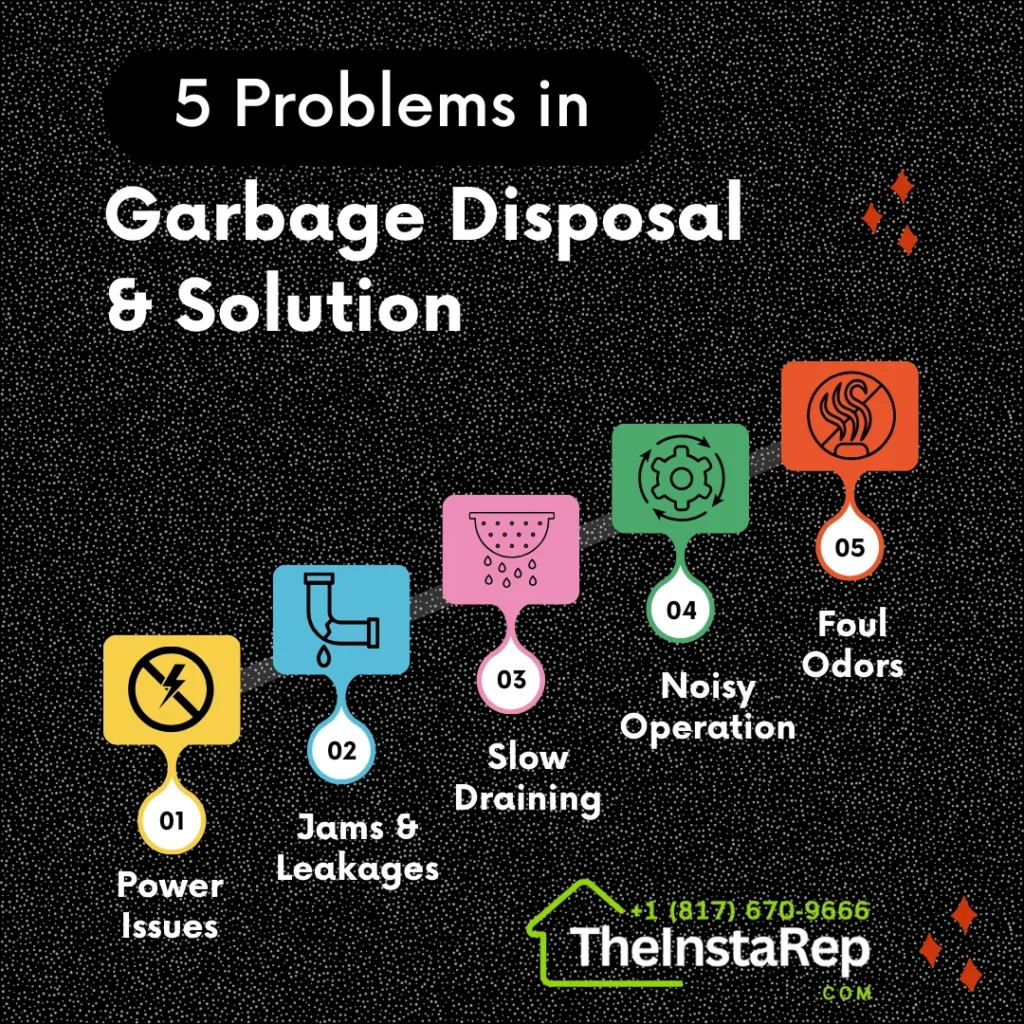Problems With Garbage Disposal and Their Solutions
If your garbage disposal isn’t working, it can be due to power issues. You can fix it by checking the power connection, pressing the reset button, inspecting the circuit breaker, and testing the wall switch to ensure proper function.

Garbage Disposal Issues with Their Solutions
| Issues | Solution |
|---|---|
| Power Issues | Damaged wiring, Moisture, Faulty Switch |
| Jams & Leakages | Power Supply or Cord, Continuity Check |
| Slow Draining | Sensor and its wiring |
| Noisy Operation | Door Seal, Door Hinges, Screw check |
| Foul Odors | Element, Switch, its connections |
However, some other issues can cause garbage disposals to stop working, such as jams, leaks, noisy operation, slow draining, or foul odors. Identify and address these problems with basic troubleshooting steps or seek professional help.
At TheInstaRep, we provide professional garbage disposal repair services. Our team of experts is always ready to assist you with any problem and provide the best services at the minimum cost. Your garbage disposal can work for you again in no time.
Book FREE Consultation visit at your doorstep!
Remember, routine maintenance and prompt care of garbage disposal issues extend their lifespan and keep things efficient for a long time.
How a Garbage Disposal Works
A garbage disposal is a kitchen appliance that grinds food waste into small pieces so that the pieces can pass through the plumbing. Its initial part is a motor, which makes a grinding plate revolve to break up the food material into fine pieces when the material contacts the impellers between the plates.
Once the material enters the disposal, a grinder cuts it into tiny pieces. Learning how this device works is the only way to maintain it properly. By understanding how the garbage disposal works, you can prevent damage and take care of essential unit maintenance.
How Do You Know if Your Garbage Disposal is Bad?
You can tell when your garbage disposal is lousy. If it’s starting to fail, pay attention to the following signs: it clogs more, makes strange noises you’ve never heard before, leaks, or doesn’t smell good. If it doesn’t turn on or grind material as quickly as it used to, it’s about time for a repair or replacement.
If you need your garbage disposal repaired, TheInstaRep is your top choice. Our team of experts is ready to fix your problem right at home.
If you stay on top of your unit early on, you can catch issues that might otherwise cause more severe problems when they intensify. Inspecting your disposal occasionally and observing its performance can lead to significantly fewer surprise breakdowns and costly repairs.
6 Reasons Your Garbage Disposal Not Working: With Solutions
1. Power Issues
Power problems are the most common cause of garbage disposal malfunction. Whether the circuit breaker has tripped, the unit is unplugged, or the switch is faulty, your disposal won’t work if it isn’t getting power.
Solution:
- Check the Power Connection: Ensure the disposal is plugged in properly. Sometimes, the plug can come loose, causing a loss of power.
- Reset the Disposal: Locate the reset button (usually red) on the bottom of the unit and press it. This can often resolve power issues caused by an overload.
- Inspect the Circuit Breaker: Check your home’s electrical panel and reset any tripped breakers. A more significant electrical issue may require professional attention if the breaker continues to trip.
- Test the Switch: If the disposal is still not working, test the wall switch. If it is faulty, replace it to restore proper function.
Book FREE Consultation visit at your doorstep!
2. Jammed Disposal
Jamming occurs when a lump of food or other foreign material wedges the mechanism, preventing it from spinning and causing waste to pile up, making your disposal completely useless.
Solution:
- Shut Off The Power: Always disconnect the disposal from the power source while attempting repairs to avoid accidents.
- Insert Hex Wrench Into Bottom: Insert a hex (Allen) wrench into the bottom of the disposal and turn the wrench to release the jam, unlocking the grinding plate and impellers.
- Remove the Obstruction: Carefully use pliers or tongs to remove the debris causing the jam. Avoid using your hands directly to prevent injury.
- Check for Damage: After you clear the jam, look for damage or wear on the disposal’s impellers (the spinning parts) or blade (the grinding plate). If you see any damage, replace it to ensure it works correctly.
3. Leaking Disposal
Some leaks might come from the sink flange, others might develop at the dishwasher connection, and other leaks could be straight from the unit. Any of those leaks can cause some damage to your cabinets and flooring if not dealt with quickly.
Solution:
- Identify Leak Source: Look for leaks around the disposal’s connections and seals, such as at the sink flange, dishwasher hose, and unit’s body.
- Tighten the Connections: Grab a wrench and tighten all the loose connections around the unit to prevent leaks.
- Replace The Seals Or Gaskets: If the gaskets are shot, replace them, which usually means disassembling parts of the disposal.
- Check For Cracks: Check the garbage disposal unit’s shell to ensure there are no cracks or other damage to the unit itself. If the unit is cracked, you must replace it to resolve the issue.
4. Noisy Operation
Unusual noises, such as grinding or rattling, often indicate a problem with the disposal’s internal components. Foreign objects, loose parts, or worn components can cause these noises.
Solution:
- Inspect for Foreign Objects: Check the disposal for any non-food items causing the noise. Use a flashlight to get a clear view of the grinding chamber.
- Tighten Mounting Screws: Loose mounting screws can cause vibrations and noise; tighten them as needed. Ensure the unit is securely attached to the sink flange.
- Replace Worn Parts: If components like impellers are worn, consider replacing them. Worn parts can lead to inefficient grinding and increased noise levels.
- Balance the Unit: Make sure the disposal is appropriately balanced and aligned. An unbalanced unit can cause excessive noise and vibrations during operation.
5. Slow Draining
Slow draining is usually the result of too much food waste or grease in the disposal or plumbing buildup, leading to more backups and decreased waste processing efficiency.
Solution:
- Clean the Disposal: Run cold water and pour a disposal cleaner (or a combination of baking soda and vinegar) into the unit. The cold water and acid will work to loosen any gunk inside the disposal.
- Check the P-Trap: Remove the P-trap under the sink and empty any gunk accumulated when you check the faucet. Hold a bucket under the pipe to catch any water or debris that might spill.
- Flush the Pipes: Wiggle the pipes that could be connected to the disposal. The more precise your plumbing, the better the drain.
- Prevent Future Buildup: Grind a small piece of ice and a lemon peel for a minute every week or two to help keep the disposal fresh and grime-free.
6. Foul Odors
Foul smells emanating from your garbage disposal are usually due to food particles trapped inside the unit. Over time, these particles can decompose and create unpleasant odors.
Solution:
- Clean the Blades: Mix ice and salt in a food processor to blast buildup from the blades. The ice helps to dislodge debris, while the salt abrades the blades, similar to how whitening toothpaste does your teeth.
- Use Citrus Peels: Grind some up to help eliminate odors and leave behind a pleasant scent. Citrus peels also release natural oils that penetrate and break down residue.
- Regular Maintenance: Clean food regularly and prevent it from building up or developing odors. The surest way is to operate the disposal with cold or lukewarm water for 30 to 60 seconds after use. This should be done daily for heavy use or weekly for light use. Another way is to use a disposal cleaner.
- Deep Clean: If that doesn’t work, remove the disposal and thoroughly clean it, reaching under and around the blades where food particles can become trapped.
7. Strange Noises from the Oven
Power problems are the most common cause of garbage disposal malfunction. Whether the circuit breaker has tripped, the unit is unplugged, or the switch is faulty, your disposal won’t work if it isn’t getting power.
Solution:
- Check the Power Connection: Ensure the disposal is plugged in properly. Sometimes, the plug can come loose, causing a loss of power.
- Reset the Disposal: Locate the reset button (usually red) on the bottom of the unit and press it. This can often resolve power issues caused by an overload.
- Inspect the Circuit Breaker: Check your home’s electrical panel and reset any tripped breakers. A more significant electrical issue may require professional attention if the breaker continues to trip.
- Test the Switch: If the disposal is still not working, test the wall switch. If it is faulty, replace it to restore proper function.
Book FREE Consultation visit at your doorstep!
People Also Ask – FAQs
Conclusion
If your garbage disposal is acting up, properly disposing of your trash may become more complex. Fortunately, arming yourself with knowledge of some common problems and solutions can help you catch and fix problems quickly. If you have persistent issues or require help, we are here to help.
At TheInstaRep, our expert technicians can troubleshoot and repair garbage disposal problems. We are just a call away and can come to your home to service your garbage disposal.
